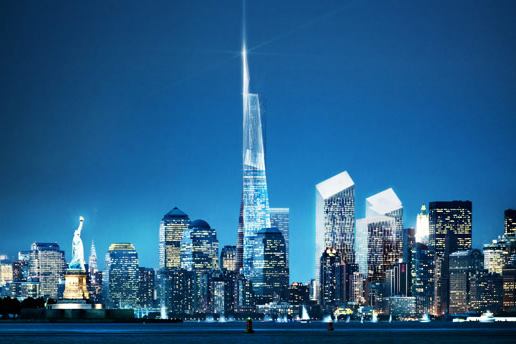There is not going to be a spire on 1 World Trade Center. Instead, what was once to be the Freedom Tower, twisting itself up to an attempt at symbolism at 1,776 feet above sea level, will now be a tall box whose tapers will lead up to a flat top with an antenna on top. There could be no better symbolism both for both America’s and architecture’s lack of vision or daring, and for our transformation from a meatspace society to one that lives on Twitter and orders from Amazon.com.
When Daniel Libeskind, AIA, won the competition for the redesign of ground zero back in the Stone Age, there was some hope that we would see something inspiring and beautiful. But there were already many questions over whether New York needed or would ever be able to absorb the millions of square feet of office and retail space his plans envisioned. There were also questions about how Libeskind’s particular vision might develop. It might have been better to think of the area, some of us felt, as being a tapered edge to the financial core, effecting the transition to waterfront living that was beginning to rise up from Battery Park to the Lincoln Yards. It might also have been good to fundamentally rethink the relationship between public space and imagery and private construction and use. The vagaries of insurance settlements, however, combined with Libeskind inability to control the design’s development and America’s wounded pride and sense of bravura to lead to a call for more—only bigger—of the same.
Despite some inventiveness in the original scheme, the results promise to be, more than anything else, blander. I cannot yet pronounce on the designs of the towers, which are not yet finished, nor can I speak about the memorial, which I have not visited. I can say from walking around the area periodically over the last few years is that what is visible now fits the currently trendy word: “meh.” Not bad, not good, but just there.
More than that, the loss of the spire, which originally twisted out of a tower that worked hard to decompose its massive girth into planes shooting up toward that culmination, speaks of a complete capitulation to both fear and greed. The base has already turned into a concrete sleeve sheathed in a business suit of metal coating, and now the top is to be just another flat buzz cut surmounted by a node in the telecommunications and data empires swirling around us.
Perhaps that is appropriate: As reality becomes less and less interesting, this spire will be a marker of what really matters. Modernism at its core wants to be so abstract, so governed by function, so rationalized, and so transparent that it disappears into nothing. All those forms reduced to their basics, the glass and the thin members, and, these days, the spiraling forms and stacked boxes, are just placeholders for that eventual disappearance. You can almost imagine the World Trade Center spire either just hovering in the air someday, or perhaps dissolved into invisible points that will tether connectivity in ways we cannot yet envision.
For now, though, the spire will remind us of nothing so much of the fact that we have given up trying to answer the world of instant-everything-everywhere with monuments or objects of memory. We do not make something out of etherspace, we let it unmake the meaning of our physical world. We would rather have safety than possibilities, anonymity rather than memory, communication than vision, and comfort rather than a reminder of what we do now know or cannot yet make. The spire is a beacon in a landscape of meh.
